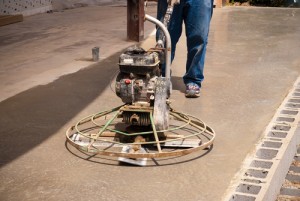We carry just about anything you could need to finish a concrete slab, including power trowels available for rent.
If you have your own power trowel, you’ll want to check the manufacturer’s maintenance guidelines to ensure you keep your machine running smoothly. Here are a few tips to keep in mind for maintenance that’s required as often as every day your power trowel is in use.
Daily maintenance
Without question, the most important daily task to keep your power trowel looking and working like-new is to power wash it. Grease and debris can wreak havoc on many of the trowels components, so employing a power washer at the end of the day will help keep everything clean and ready for tomorrow. There’s also the more obvious concern of allowing concrete to dry where it’s not needed, either on the machine itself, or dripping onto the floor.
You’ll also need to carefully inspect engine components each day. This is typically best done before starting work. Specifically, you’ll want to look at air filters because concrete dust builds up quickly and chokes power out of the engine.
As with any piece of equipment, it’s also a good idea to check on fluid levels, including engine oil, and liquid coolant.
Finally, before turning your power trowel on for the first time each day, do a quick visual inspection to ensure each component is attached correctly and safety guards are in place.
Weekly Maintenance
On a weekly basis, you’ll want to inspect the underside of the power trowel. In particular, you need to check the blades themselves, and the spider arm, which holds the blades. Damage to any of these can cause irregularities or patterns in your concrete surface. If you’re experienced enough, you may be able to tell something is wrong as you’re operating the trowel, but it is still best to catch a problem before it impacts the concrete.
On most power trowels, the spider arm is adjustable, which allows you to compensate when it gets bent or slightly misplaced.
The drive belt also needs to be checked regularly. When left unchecked, rubber belts can be destroyed by heat, which can result in hours of lost time. Checking it each week allows you to replace the belt at the first signs of wear.
Monthly Maintenance
Your daily checks of fluid levels and engine components may lead to some necessary monthly maintenance tasks. Additional work may be needed periodically, and while oil and coolant changes aren’t likely needed every month, you can safely set aside some time each month for work that goes beyond your typical daily and weekly checks.
Annual maintenance
A year’s worth of use for a power trowel is typically between 300 and 500 hours of use. You may exceed that in a few months, or over the span of multiple years depending on your needs.
Even if you haven’t reached the amount of use required for the manufacturer’s annual engine maintenance schedule, there are some yearly tasks that are best practices.
For example, gear box oil should be changed about every 12 months. This greatly extends the amount of life you’ll get from the power trowel’s gears and is a good idea even if you don’t use the trowel as much as a typical year’s usage.
A yearly inspection is also a good time to adjust blades and arms, and the blade-tilt mechanism. Maintenance on the throttle cable is also critical for walk-behind trowels.
For materials, equipment and other supplies related to concrete projects, Maxwell Supply in Tulsa is the only call you need to make. Let us know what you’re searching for by stopping by, or calling 918-836-8606.
